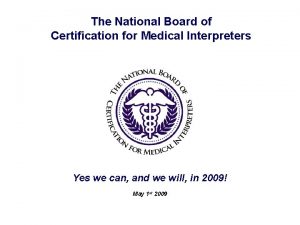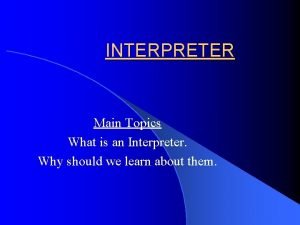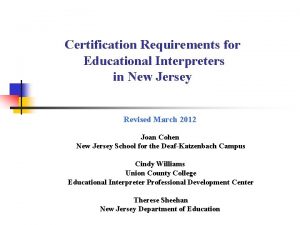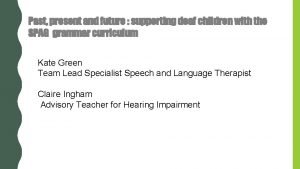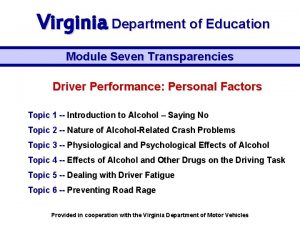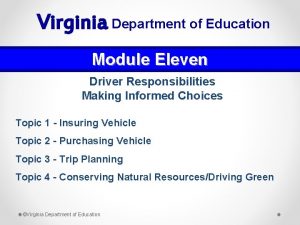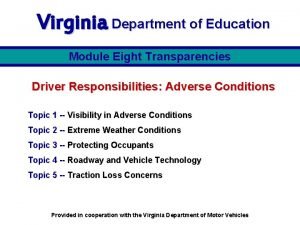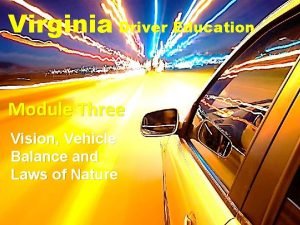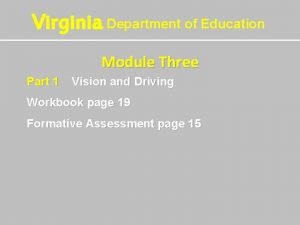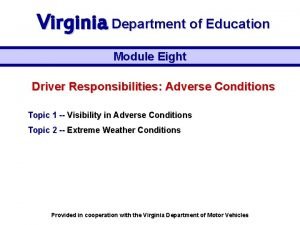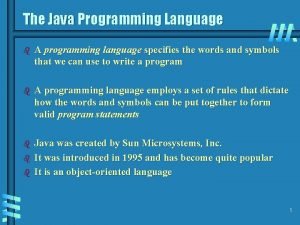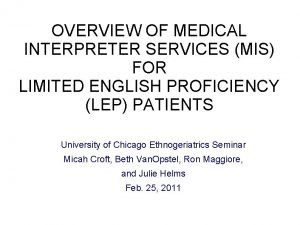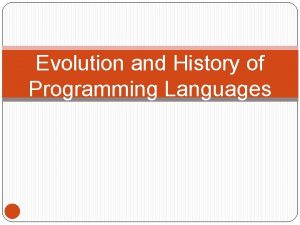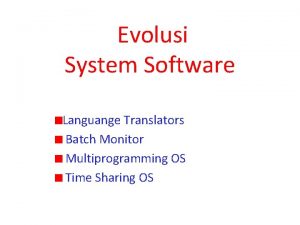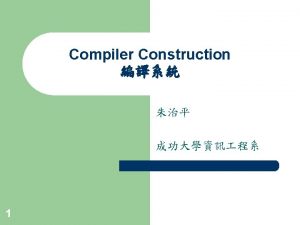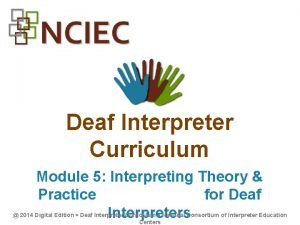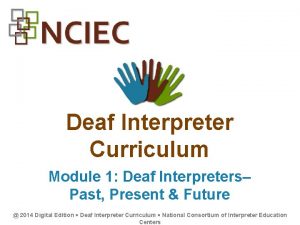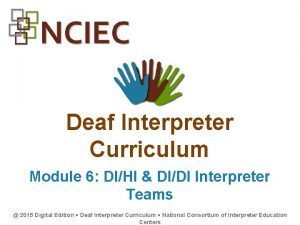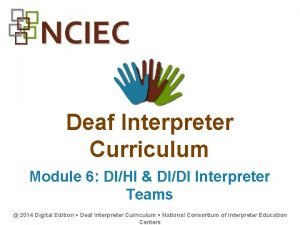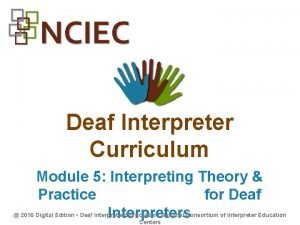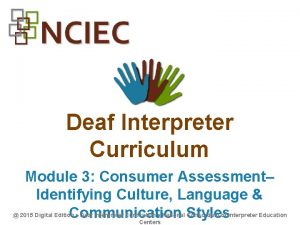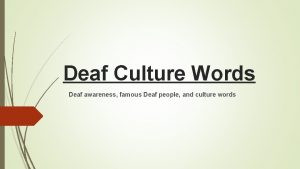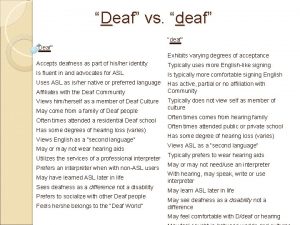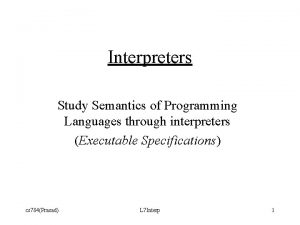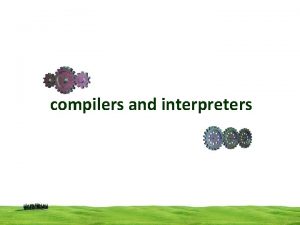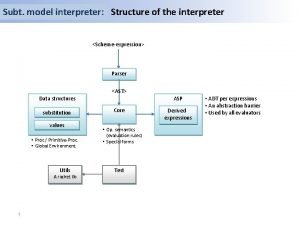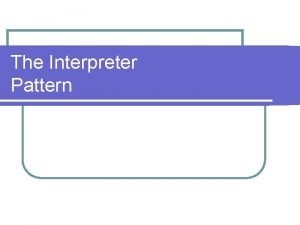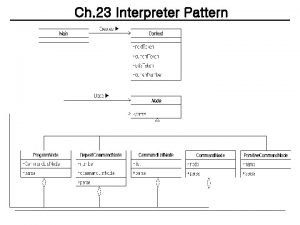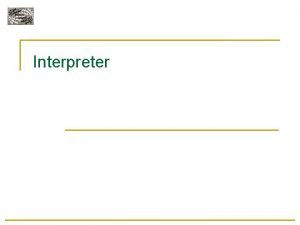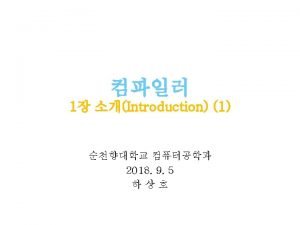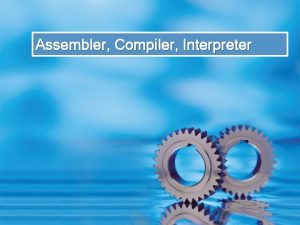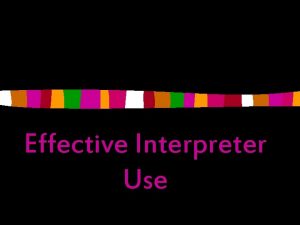Deaf Interpreter Curriculum Module 1 Deaf Interpreters Past



















- Slides: 19

Deaf Interpreter Curriculum Module 1: Deaf Interpreters– Past, Present & Future @ 2015 Digital Edition Deaf Interpreter Curriculum National Consortium of Interpreter Education Centers

Module 1: Deaf Interpreters– Past, Present & Future Unit Titles & Sequence Historical Evolution of Deaf Interpreting Foundational, Language, Cultural & Communication Competencies Interpreter Service Models & Methods of Interpreting Language, Culture, Oppression & the Deaf-World Community Deaf Interpreter or Deaf Advocate? @ 2015 Digital Edition Deaf Interpreter Curriculum National Consortium of Interpreter Education Centers

Unit 1: Historical Evolution of Deaf Interpreting Key Questions What knowledge and skills are required? Why do we need a specialized curriculum in addition to generic curricula offered in ITPs? In what situations are Deaf interpreters needed and beneficial? How can we improve others’ perspectives of Deaf @ 2015 Digital Edition Deaf Interpreter Curriculum National Consortium of Interpreter Education Centers

Unit 1: Historical Evolution of Deaf Interpreting Origins of Deaf Interpreting When did Deaf people begin to function as interpreters? What were early Deaf interpreter roles & functions? Research: Historical milestones @ 2015 Digital Edition Deaf Interpreter Curriculum National Consortium of Interpreter Education Centers

Unit 1: Historical Evolution of Deaf Interpreting Deaf Interpreters: A Brief History In colonial New England, Matthew Pratt, a Deaf person, interpreted for Sarah Pratt, his wife, during her 1683 Puritan conversion by translating her signs to written text for Puritan elders and translating the elders’ written text to signs for Sarah (Carty, Macready & Sayers, 2009) Forestal (2011): Traditionally, Deaf people have undertaken a variety of translation and interpreting roles within the Deaf community (Bauman, 2008; Stone, 2007); only recently they have been recognized as Deaf Interpreters within the interpreting profession, as they are “brought in” to work with hearing interpreters to provide optimal information access to Deaf individuals @ 2015 Digital Edition Deaf Interpreter Curriculum National Consortium of Interpreter (Langholtz, 2004) Education Centers

Unit 1: Historical Evolution of Deaf Interpreting Deaf Interpreters: A Brief History Deaf Interpreters now practice in myriad settings, such as courts, hospitals, work-related sites, training programs, conferences, theatres, and classrooms across the country, primarily in major cities. They work as translators from spoken or written English into ASL, international sign language, or in a gestural form. They are now everywhere in the field of interpreting with Deaf people and where ASL-English interpreting occurs (Forestal, 2005) Deaf interpreting has been around for centuries. Deaf people have been interpreting for each other and others since the first oldest known mention of sign language in @ 2015 Digital Edition Deaf Interpreter Curriculum National Consortium of Interpreter BC (Per Eriksson, The History of Deaf People) Education 427 -347 Centers

Unit 1: Historical Evolution of Deaf Interpreting RID Reverse Skills Certificate During what years was the RSC offered? Describe typical RSC roles & work settings How did RSC holders benefit consumers? What led to RSC suspension? What is the Deaf Caucus? What is relay interpreting called today? @ 2015 Digital Edition Deaf Interpreter Curriculum National Consortium of Interpreter Education Centers

Unit 1: Historical Evolution of Deaf Interpreting Interpreter Certification: Brief History RID has since 1964 offered national testing & certification for sign language interpreters. From 1972 to 1988, RID offered the Reverse Skills Certificate (RSC); since then they have offered Certified Deaf Interpreter (CDI) testing and certification. During the late 1980 s to the mid-2000 s, the NAD offered national testing and certification for sign language interpreters. In 1993, RID and NAD formed a task force; they later agreed to develop a new joint test and certification system for interpreters. In 2005, the NAD-RID National Interpreter Certification (NIC) test was released, followed by the NAD-RID Code of Professional Conduct (CPC). of Interpreter Both @ 2015 Digital Edition Deaf Interpreter Curriculum National Consortium Education Centers

Unit 1: Historical Evolution of Deaf Interpreting RID Standard Practice Paper: Use of a Certified Deaf Interpreter What functions of DIs go beyond the SPP? How does the SPP advocate for use of Deaf interpreters? In what ways should the SPP be updated? @ 2015 Digital Edition Deaf Interpreter Curriculum National Consortium of Interpreter Education Centers

Unit 1: Historical Evolution of Deaf Interpreting RID Certified Deaf Interpreters What are the benefits of DI/HI teams? In what ways do CDIs benefit Deaf & Deaf. Blind consumers? What specialized training requirements do prospective & working Deaf interpreters require? In what ways are the roles & functions of Deaf interpreters evolving? How can we further the professionalization of Deaf @ 2015 Digital Edition Deaf Interpreter Curriculum National Consortium of Interpreter Education Centers interpreters?

Unit 2: Foundational, Language, Cultural & Communication Competencies Key Questions How can Deaf interpreters use formative experiences for selfassessment? How do foundational competencies prepare individuals to work as Deaf interpreters? Foundational competences support what Deaf interpreter skill sets? @ 2015 Digital Edition Deaf Interpreter Curriculum National Consortium of Interpreter Education Centers

Unit 2: Foundational, Language, Cultural & Communication Competencies Deaf Interpreters What are four key skill areas? Why is it important to analyze one’s own biases? What linguistic skills are required? Why is it important to be comfortable in a variety of bicultural and bilingual settings? What areas of interpreter practice are of primary @ 2015 Digital Edition Deaf Interpreter Curriculum National Consortium of Interpreter Education Centers importance?

Unit 2: Foundational, Language, Cultural & Communication Competencies Foundational Competencies What is your exposure to ASL & other signed languages? What are your past experiences dealing with various communication modes and forms used by Deaf people? How have these experiences influenced you as a Deaf interpreter? Why is analysis of personal challenges (e. g. , comprehending situations, interpreters, communication styles) of critical importance? How have or will personal experiences of discrimination & oppression impact you as a Deaf @ 2015 Digital Edition Deaf Interpreter Curriculum National Consortium of Interpreter Education Centers

Unit 2: Foundational, Language, Cultural & Communication Competencies Language & Cultural Competencies Evaluate your ASL skills; in what areas are you native or native-like? Are you fluent in additional signed language/s? Do you have spontaneous use of pragmatic & sociolinguistic features of ASL? Are you adept and flexible in working across a range of registers, genres, and variations of ASL? How will you develop competencies in the above areas? @ 2015 Digital Edition Deaf Interpreter Curriculum National Consortium of Interpreter Education Centers

Unit 2: Foundational, Language, Cultural & Communication Competencies Language & Communication Competencies Review rubrics for ASL, visual gestural communication, and home signs Work in pairs, share experiences of growing up, then use rubrics to assess one’s own and partner's language skills Engage in. Interpreter dialogue @ 2015 Digital Edition Deaf Curriculumon National Consortium of Interpreter Education Centers

Unit 3: Interpreter Service Models & Methods of Interpreting Evolution of Interpreter Service Models & Application to Deaf interpreters Helper Conduit/machine Language facilitator Bilingual-bicultural mediator Ally @ 2015 Digital Edition Deaf Interpreter Curriculum National Consortium of Interpreter Education Centers

Unit 3: Interpreter Service Models & Methods of Interpreting Which Methods Used Most by Deaf Interpreters? Simultaneous Consecutive Application of Processes to Deaf Interpreters? Interpretation Transliteration Sight Translation @ 2015 Digital Edition Deaf Interpreter Curriculum National Consortium of Interpreter Centers Mirroring Education

Unit 4: Language, Culture, Oppression & the Deaf-World Community Personal Experiences: Impact Deaf Interpreter Effectiveness & Practice Discrimination Oppression Lack of access to communication How can Deaf interpreters mediate the potential pitfalls of identifying with consumers’ experiences? @ 2015 Digital Edition Deaf Interpreter Curriculum National Consortium of Interpreter Education Centers

Unit 5: Deaf Interpreter or Deaf Advocate? Self-Analysis What does advocacy mean? Does the work of Deaf interpreters include advocacy? Do you want to be a Deaf interpreter or a Deaf advocate? How might your role/s affect your work as a Deaf @ 2015 Digital Editioninterpreter? Deaf Interpreter Curriculum National Consortium of Interpreter Education Centers
 National board of medical interpreters
National board of medical interpreters Pros and cons of compilers and interpreters
Pros and cons of compilers and interpreters Introduction to interpreter
Introduction to interpreter New jersey interpreters
New jersey interpreters Deaf past tense
Deaf past tense C device module module 1
C device module module 1 Module 10 topic 1 drivers ed
Module 10 topic 1 drivers ed Drivers ed module 7 topic 3
Drivers ed module 7 topic 3 Module 11 topic 1 insuring a vehicle
Module 11 topic 1 insuring a vehicle Module 8 topic 1
Module 8 topic 1 What is vehicle balance
What is vehicle balance Roll drivers ed
Roll drivers ed S.e.e.i.t method driving
S.e.e.i.t method driving Module 8 topic 1
Module 8 topic 1 Java interpreter
Java interpreter Mis interpreter
Mis interpreter Debugging history
Debugging history Pengertian compiler dan interpreter
Pengertian compiler dan interpreter Assembler, compiler and interpreter
Assembler, compiler and interpreter National consortium of interpreter education centers
National consortium of interpreter education centers
